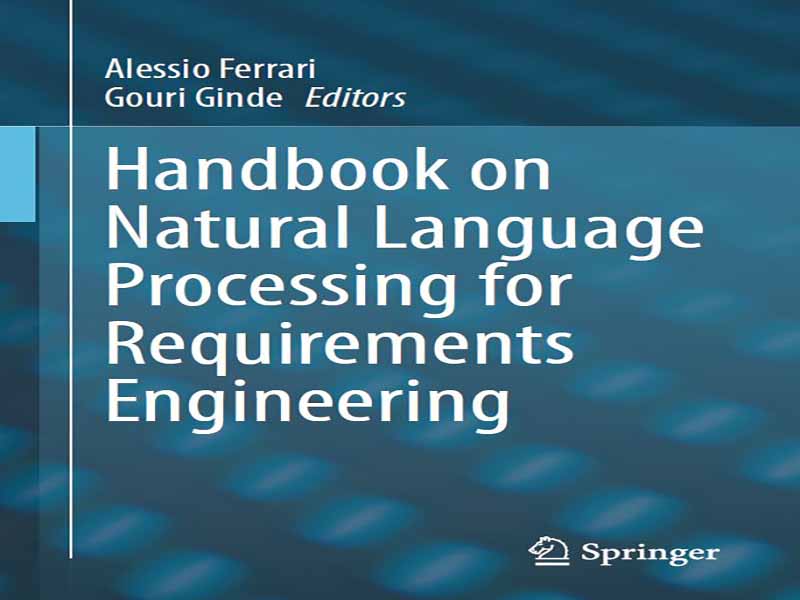- عنوان کتاب: Handbook on Natural Language Processing for Requirements Engineering
- نویسنده: Alessio Ferrar
- حوزه: پردازش زبان طبیعی
- سال انتشار: 2025
- تعداد صفحه: 525
- زبان اصلی: انگلیسی
- نوع فایل: pdf
- حجم فایل: 13.3 مگابایت
الزامات هم سنگ بنای و هم نقطه درد مهندسی نرم افزار هستند. آنها عملکردها و کیفیت هایی را که نرم افزار باید برای برآوردن نیازهای ذینفعان از خود نشان دهد، تعریف می کنند، اما تحلیل و مدیریت نادرست آنها می تواند منجر به خطاهای پرهزینه و تاخیر در چرخه عمر توسعه شود. علاوه بر این، رسیدگی به نیازها در پروژههای بزرگ به دلیل تمایل آنها به تغییر، تکثیر تعداد، تنوع از نظر سطوح انتزاع و دیدگاههای ذینفعان میتواند چالشبرانگیز باشد. آخرین اما نه کماهمیت، الزامات بهطور بدنام در زبان طبیعی بیان میشوند، رسانهای که دارای تفاسیر متعدد است. این ابهام ذاتی به خوبی با دقت و دقت مورد نیاز در توسعه نرم افزار همخوانی ندارد. Requirements Engineering (RE) قصد دارد با این مسائل به طور سیستماتیک مقابله کند و وظایفی مانند تشخیص نقص، قابلیت ردیابی، طبقه بندی و موارد دیگر را در بر بگیرد. با این حال، انجام این وظایف به صورت دستی می تواند مستعد خطا باشد، زیرا نیاز به توجه دقیق به جزئیات دارد و گاهی اوقات خسته کننده است زیرا فعالیت های RE اغلب ممکن است تکرار شوند. به این دلایل، مهندسان نیازمندیها مدتها امیدوار بودند که شرکای خودکار به آنها در رسیدگی به چالشهای مرتبط با الزامات زبان طبیعی کمک کنند و ناراحتیهای روزانهشان را برطرف کنند. پردازش زبان طبیعی (NLP) حوزه ای از هوش مصنوعی است که بر توسعه الگوریتم ها و مدل هایی برای پردازش، تفسیر و درک داده های زبان طبیعی تمرکز دارد. به منظور پشتیبانی از وظایف RE با ابزارهای خودکار و تسهیل کار مهندسین نیازمندیها، محققان بیش از 20 سال با تکنیکهای NLP آزمایش کردهاند و رویکردهای موجود را برای نیازهای خاص حوزه RE تطبیق دادهاند. علاقه به تکنیکهای NLP برای RE اخیراً شاهد رشد قابل توجهی بوده است، همچنین به دلیل پیشرفتهای فنآوریهای NLP، که به طور فزایندهای در دسترس محققان و حتی عموم مردم قرار گرفته است، با ابزارهایی که وظایف پیچیدهای مانند ترجمه ماشینی و پاسخگویی به سؤالات را با سطوح عملکرد تقریباً انسانی انجام میدهند. ما ChatGPT را ذکر نمی کنیم زیرا این نام ممکن است به زودی با توجه به سرعت تکامل زمینه NLP منسوخ شود. هدف این کتابچه در مورد پردازش زبان طبیعی برای مهندسی نیازمندی ها ارائه یک راهنمای جامع در مورد اینکه چگونه NLP می تواند برای تقویت جنبه های مختلف RE به کار گرفته شود، خواننده را از کاوش در مفاهیم و تکنیک های اساسی به اجرای عملی NLP برای راه حل های RE در سناریوهای دنیای واقعی هدایت می کند. انگیزه این کتاب سه چیز است. اولاً، حوزه NLP برای RE مجموعه وسیعی از دانش را در طول سال ها جمع آوری کرده است، با این حال این دانش در نشریات و مکان های مختلف پراکنده شده است، و آن را برای افراد علاقه مند به چالش می کشد تا به طور کارآمد یک نمای کلی جامع را به دست آورند. هدف این کتاب تثبیت این دانش در یک منبع واحد و در دسترس است و از طریق پیچیدگی های ادغام NLP با RE، نقشه راه روشنی را در اختیار خوانندگان قرار می دهد. ثانیا، NLP در حال حاضر یک دوره دگرگونی را تجربه می کند که عمدتاً توسط پیشرفت در مدل های زبان بزرگ (LLM) هدایت می شود. این مدلها فرصتهای بیسابقهای را برای مقابله با چالشهای RE با اثربخشی بیشتر ارائه میدهند. این کتاب با توضیح اینکه چگونه NLP میتواند از RE پشتیبانی کند و تکنیکها و متدولوژیهای پیشرفته را به نمایش بگذارد، به عنوان دروازهای برای محققان و پزشکان برای استفاده از این پیشرفتها در کاربردهای عملی عمل میکند. در نهایت، در طول زندگی حرفهای خود، شاهد مشکلاتی بودیم که تمرینکنندگان در رسیدگی به الزامات زبان طبیعی و پتانسیل NLP برای کاهش این چالشها با آن مواجه بودند. بنابراین هدف ما این است که به آنها کمک کنیم تا بفهمند چگونه می توانند NLP را برای بهبود فرآیند RE خود و در نهایت کیفیت سیستم های خود اعمال کنند.
Requirements are both the cornerstone and the pain point of software engineer- ing. They define the functionalities and qualities that the software must exhibit to satisfy stakeholder needs, yet their incorrect analysis and management can lead to costly errors and delays in the development lifecycle. Moreover, require- ments can become challenging to handle in large projects due to their tendency to change, proliferation in number, diversification in terms of abstraction levels and stakeholders’ perspectives considered. Last but not least, requirements are notoriously expressed in natural language, a medium subject to multiple inter- pretations. This inherent ambiguity does not align well with the precision and rigour required in software development. Requirements Engineering (RE) aims to tackle these issues systematically, in- corporating tasks such as defect detection, traceability, classification and more. However, performing these tasks manually can be error-prone, as it demands meticulous attention to detail and is sometimes tedious since RE activities can often become repetitive. For these reasons, requirements engineers have long hoped for automated partners to assist them in addressing the challenges asso- ciated with natural language requirements, and relieve their daily frustrations. Natural Language Processing (NLP) is a field of artificial intelligence focus- ing on developing algorithms and models to process, interpret and understand natural language data. In order to support RE tasks with automated tools and facilitate the work of requirements engineers, researchers have experimented with NLP techniques for over 20 years, tailoring existing approaches to the specific needs of the RE domain. The interest in NLP techniques for RE has recently witnessed significant growth, also driven by the advancements in NLP technolo- gies, which have become increasingly accessible to researchers and even to the general public, with tools that perform complex tasks such as machine transla- tion and question answering with near-human levels of performance. We do not mention ChatGPT because this name may soon become obsolete given the pace of evolution of the NLP field. This Handbook on Natural Language Processing for Requirements Engineer- ing aims to provide a comprehensive guide on how NLP can be leveraged to enhance various aspects of RE, leading the reader from the exploration of fun- damental concepts and techniques to the practical implementation of NLP for RE solutions in real-world scenarios. The motivation for this book is threefold. Firstly, the field of NLP for RE has accumulated a vast body of knowledge over the years, yet this knowledge is dispersed across various publications and venues, making it challenging for inter- ested individuals to efficiently obtain a comprehensive overview. This book aims to consolidate this knowledge into a single, accessible source, providing readers with a clear roadmap through the complexities of integrating NLP with RE. Secondly, NLP is currently experiencing a transformative period, mainly driven by advancements in Large Language Models (LLMs). These models present un- precedented opportunities to tackle RE challenges with enhanced effectiveness. By clarifying how NLP can support RE and showcasing state-of-the-art tech- niques and methodologies, this book serves as a gateway for researchers and practitioners to leverage these advancements in practical applications. Lastly, throughout our career, we have witnessed firsthand the struggles practitioners face in handling natural language requirements and the potential of NLP to alle- viate these challenges. We thus aim to help them understand how they can apply NLP to enhance their RE process and, ultimately, the quality of their systems.
این کتاب را میتوانید از لینک زیر بصورت رایگان دانلود کنید:
Download: Handbook on Natural Language Processing for Requirements Engineering



































نظرات کاربران